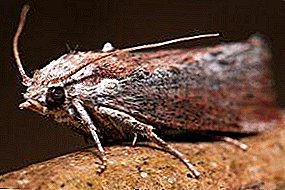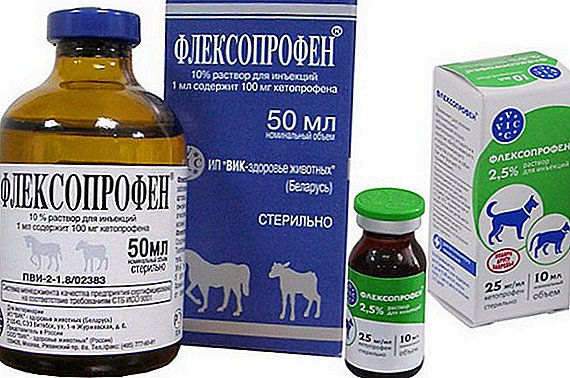
An inconspicuous butterfly, called "wax moth", despite its small size, has gained fame as a formidable enemy of bees.
Beekeepers are tirelessly fighting the wax moth and in every way protect their farms from uninvited guests.
Fortunately, for this there are plenty of effective tools and methods.
Today, consider what is wax moth? How is it dangerous and how to get rid of the wax moth in the hive?
What do we know about the pest?
Wax moth refers to nocturnal moths belonging to the Ognivok family. This insect lives only in areas of developed beekeeping, being the most dangerous pest of beehives.
Big wax moth differs in larger sizes. Its wingspan can reach 35 mm.. Coloring the front wings of the bee moth combines brownish-yellow and grayish-brown shades, while the rear wings are cream.
 In a small bee moth the wings in a span reach no more than 24 mm.. The color of its front wings is gray-brown, and the hind wings are silvery-white.
In a small bee moth the wings in a span reach no more than 24 mm.. The color of its front wings is gray-brown, and the hind wings are silvery-white.
Adult wax moth does not require food., because its digestive organs are practically undeveloped. She lives at the expense of stocks accumulated during the development period. The life span of the females is about 2 weeks, the males are two to three weeks.
Female butterflies very prolific. Making her way into the hive at dusk or at night, she lays up to 300 eggs in one clutch in gaps, crevices or on the floor in wax. For a short life, one female of this moliform butterfly is able to lay 1,500 eggs.
After about 10 days eggs appear white larvae about 1 mm in size with a light yellow head. Eating intensively, they gradually turn into caterpillars of dark gray color up to 2-3.5 cm long.
After 30 days from the beginning of its development, the caterpillar forms a cocoon, holding it in lye or corners of the hive, and pupates. After 10-11 days, a new butterfly flies out of the cocoon, ready to produce the next generation in two weeks of its existence.
What the wax moth looks like - the photo below:






Harm done
The wax moth is real disaster for beekeepers. Her gluttonous larvae eat exclusively bee products. During development, they are able to bring the hive to such a state that the bee family does not stand up to such a harmful neighborhood and leaves its home.
At the beginning of existence, the food of the larvae is perga and honey. Having got stronger, they are already beginning to eat cellular wax, insulating material, the remains of bee brood. Caterpillars mercilessly spoil the honeycomb, forming in them numerous tunnels.
Moving along the moves, they leave behind them bowel movements and a thin cobweb, sealing the honeycombs with it and preventing the bees from putting off honey.
One caterpillar alone wax moth for the period of its development can damage up to 500 honeycombs and even more. With a large number of pests, almost all the cells are filled with cobwebs and turn into dust.
The air in the hive becomes musty and gets an unpleasant odor. As a result the bee family weakens and most often leaves the hive, and at worst kills.
Beekeepers have gained considerable experience and invented many ways to get rid of the uninvited guest. But it should be said that the tincture based on the larvae of the wax moth has many medicinal properties.
How to deal with moth wax?
 Hive pest control begins with preventive measures. First of all, beekeepers try to maintain only healthy bee colonies, creating all the necessary conditions for them.
Hive pest control begins with preventive measures. First of all, beekeepers try to maintain only healthy bee colonies, creating all the necessary conditions for them.
Strong bees themselves are able to actively resist pests.. Working individuals find larvae, eat them, and found pupae are sealed with propolis. Bees-guards hunt butterflies and, catching them, throw them out.
In order to prevent effective the following activities:
- Important inspect honeycomb regularly both in beehives and in storage facilities, and immediately detected pests are destroyed.
- Hive, apiary and storage shed should be kept clean., at the bottom of the hives should not be pieces of wax and other debris.
- Bee houses must be kept in good condition., without cracks, gaps and cracks, there should not be even the slightest loophole for the penetration of a dangerous pest.
- Need to provide bees with free access to any part of the hive for their independent fight with the roe.
- Some of the old cells (about 30%) are recommended to be replaced with new ones every year, and damaged ones should be removed.
- To prevent the larvae from crawling into other hives, it is recommended to dig up the grooves around them, filling them with water.
- Wax material must be kept in tightly closed containers. Do not keep wax in the apiary for long, it is desirable to immediately take it for recycling.
- Spare cells should be stored in a cool, clean and dry place. with good ventilation. It is desirable that they are in a lockable cabinet or spare hives.
- Around the apiary is useful to grow herbs, which is afraid of the wax moth. These include oregano, hops, mint, fragrant geranium, wormwood. Bundles of these herbs can be placed in the hive - in the upper and lower parts.
- An excellent deterrent is ordinary garlic - one slice of garlic is cut into three pieces, which are placed on pieces of canvas on the bottom of the hive or under insulation in the upper part.
- To discourage the wax moth from the soot storage, it is placed "bouquets" of the above herbs, adding to them the immortelle, ledum and walnut leaves.
 Effective in the destruction of adults special baitthat are made from honey and perga with the addition of a small amount of water and fresh yeast.
Effective in the destruction of adults special baitthat are made from honey and perga with the addition of a small amount of water and fresh yeast.
The bait is poured into shallow open containers and at dusk they are placed around the hives all night. Butterflies flock to an attractive smell for them, climb into containers and sink. With the onset of morning, the bait is removed until the next night, and the pests are destroyed.
If the offspring of the wax moth has already settled in the hives, in the arsenal of beekeepers there are many methods, subtleties and secrets that can help quickly get rid of this scourge. Consider the most popular and effective ones.
Beeswaxed by moths honeycomb pulled out of the hive and free from caterpillars tapping on the frame with a chisel or palm. Pests crawl out of their shelters and fall down. They are immediately destroyed, and damaged cells are melted down onto the raw wax.
The hives are then disinfected by firing a blowtorch on the inner surfaces of the bee house. At the same time pay special attention to the corners of the hive.
Effective disinfection of affected cells with 80% acetic acid at a dosage of 200 ml per 1 square meter. A pile of honeycombs is put in a free hive, a layer of soft cloth or cotton wool soaked in vinegar is put on top, cover the case with a roof and wrap the whole thing with film, leaving no gaps.
Vinegar vapors, which are heavier than air, flow down the honeycomb frame, destroying pests on their path at any stage of their development. Honeycomb soak in acetic acid vapors for 3 days (at a temperature of 16 to 18 ° C), and then well ventilated. The treatment is repeated after 12-13 days.
 Excellent results brings low and high temperature processing. In winter, the frames are frozen at -10 ° C and below for 2 hours.
Excellent results brings low and high temperature processing. In winter, the frames are frozen at -10 ° C and below for 2 hours.
In the summer for these purposes, you can use the freezer in the refrigerator. Wax moths are also ruined by high temperatures - from + 50 ° C and higher.
In the spring, peeled and prepared hives are placed in small boxes. naphthalene (for example, match), placing it to the left or right of the entrance. At the time of the main honey collection, the substance is removed, and after the collection is completed and the honey is selected, the naphthalene is placed in hives again.
Affected but still fit honeycombs can be treated with sulfur dioxide. To do this, they are placed in a tightly closed box, burning combustible sulfur in a dosage of 50 g per cubic meter capacity. Honeycombs are fumigated in this way twice more: a second time in 10, and a third in 20 days..
IMPORTANT! When working with sulfur dioxide, the beekeeper should be careful to leave the room immediately after fumigation, and then carefully ventilate it.
Helps in the destruction of pests processing of cells with biological preparation "Biosife" - powdered substance with spores of bacilli tourigenzis. The tool is effective only against caterpillars wax moth.
The contents of the vial are diluted with half a liter of cold water at the rate of 30 ml per frame, and then the cells extracted from the hive are sprayed with them. Expressed the effect of the product is achieved in a day and can last for a year.
Chemical methods that help to effectively fight wax moth are application of thymol. The substance poured into gauze bags is placed for 5-10 days in the hive, placing it on the framework.
The recommended dose of the drug - from 10 to 15 g per bee colony. The procedure can be repeated twice, however, when the air temperature is 26 ° C and above, thymol should be immediately removed from the hive.
 When storing honeycombs apply the tool "Antimol" ("Paradichlorobenzene") in the proportion of 150 g per 1 cubic meter. In one tablet "Antimoli" contains 8 g.
When storing honeycombs apply the tool "Antimol" ("Paradichlorobenzene") in the proportion of 150 g per 1 cubic meter. In one tablet "Antimoli" contains 8 g.
Substance is placed between the cells placed in closed boxes. Before using the honeycomb, they must be aired for a week or a little longer.
Another anti-moth chemical - "Axomolin". Honeycombs are placed in a hive, placed on top of the framework means per 10 tablets per frame. The body of the hive is tightly closed with a film. After processing, the cells are ventilated for 1-2 days.
Moth moth wax is a very dangerous enemy, but you can cope with it. Having shown perseverance and diligence in the application of popular methods of combating the pest, you can win a confident victory over it, and preventive measures will help to consolidate the result.
Useful materials
- Find out how there are other types of moths: clothes, food and others. How to deal with them?
- Where does this pest in the apartment and the peculiarities of the fight against the food variety come from?
- What are the chemical and folk remedies for moths?












